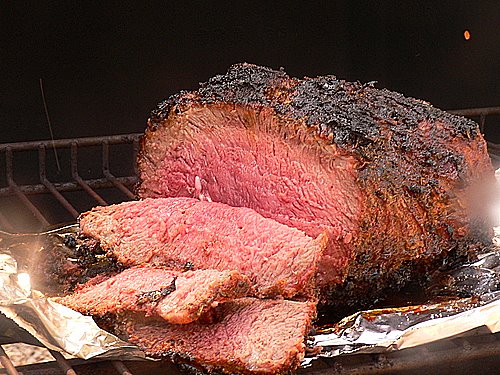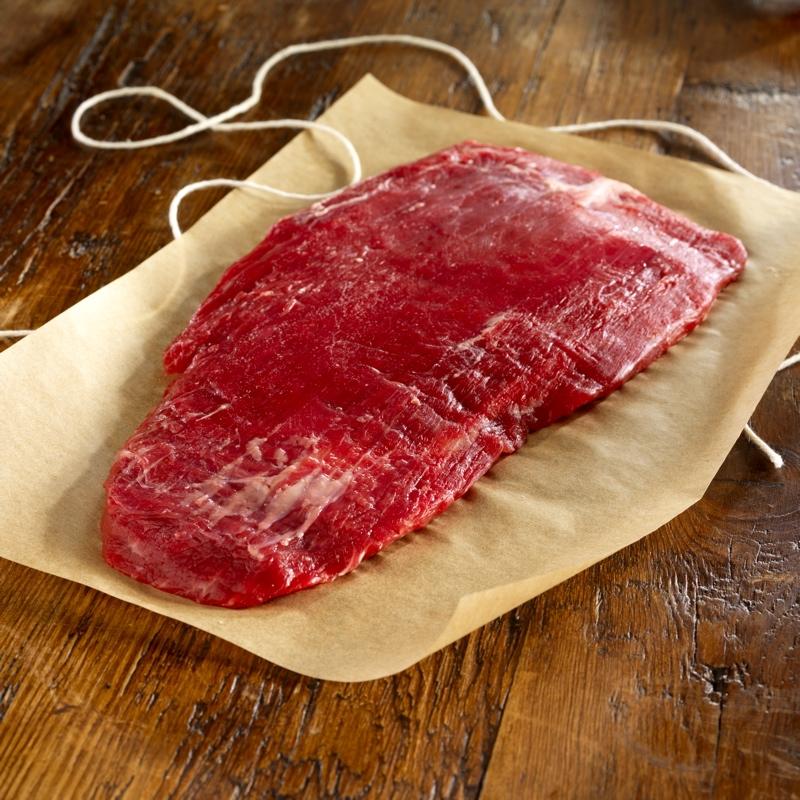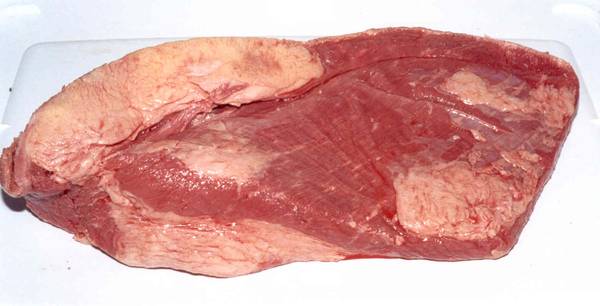
We all know the classics: rib eyes, new yorks, filets…. The tried and true staples are great. We love a grilled rib eye as much as the next meat lover. But with beef prices usually through the roof during summer, grilling a rib eye up one night a week can put a dent on your pocket book! So what are some inexpensive cuts that are great to grill…? Here are our top 5 picks!
Tri-tip
For those of you living outside of California or even the West Coast, you are probably saying Tri-tip, huh? The tri-tip originated in California and became a staple and popular favorite in Santa Maria, CA. The trend took off and tri-tips are one of the most popular items we sell in our shop. With nine different varieties of marinades and dry rubs, the tri-tip is a popular inexpensive favor to grill in the summer.
The tri-tip is a triangular shaped piece of muscle found on the primal cut known as the bottom sirloin. It is also commonly called a bottom sirloin roast and usually weighs anywhere from 1 – 3 lbs. On a whole beef there are only two tri-tips, one per side. The tri-tip is a fairly lean cut and when marinated becomes extremely tender. It’s ability for one piece of meat to feed a large crowd and the ease of cooking it makes a grilling favorite.
To cook: We recommend either a dry rub or marinade for your tri-tip and then throwing it on the grill. Making sure to sear both sides and turning it (about 15 minutes per side) or until the tri-tip reaches your desired internal temperature for doneness.. For medium rare, we recommend pulling the tri-tip at 120 degrees. As with any sort of meat, you want to let it sit after pulling it off the grill. Let it sit on the counter, covered with foil, for about 10 minutes which allows the meat to suck up the juices and finish cooking. Pulling the tri-tip at 120 degrees and letting it finish off the grill should yield you a perfectly pink centered tri-tip. To serve, simply slice the tri-tip against the grain.
Skirt Steak
We introduced marinated skirts steaks about two years ago and since then they have become a staple and one of our best sellers following the tri-tip. A skirt steak is a GREAT alternative to a tri-tip, it’s quick, it’s easy, it’s delicious, and it provides a lot of variety! It can be eaten by itself, in burritos, in stir-fry, served with pasta… The possibilities are endless. Skirt steak is probably one of my favorite things out there to grill, just because it’s so quick.
A skirt steak comes from the primal cut known as the plate, there are inside skirt steaks and outside skirt steaks… Honestly, there’s not much difference. The skirt steak is basically a flat boneless part of the diaphragm muscle of a beef. Skirt steaks really don’t get much thicker than 1/2-3/4″. Depending on how big the beef is will depend how many and how large of skirt steaks you will get. On our custom beef, the skirt steak takes a beating in the aging process so usually there is not much left of it by the time we trim it all up.
When marinated, skirt steaks become like butter. Seriously, they are so good. To cook: we recommend marinating it and then throwing it on the grill. Sear on both sides and by the time it’s done searing usually it’s cooked all the way through. And much like the tri-tip, let it sit on the counter, covered with foil, for about 10 minutes which allows the meat to suck up the juices and finish cooking. Since the skirt steak is so thin, it’s important to make sure you don’t overcook it. It’s a fast process so don’t leave the skirt steak unattended. Slice up and enjoy!
Flank Steak
Flank steaks have been my favorite this summer for fajitas, burritos, and stir fry. We also use them to make our “cowboy style” jerky which are long thin strips. Much like skirt steaks, flank steaks have a variety of uses. But unlike the skirt steak, I wouldn’t recommend a flank steak straight up but marinated or braised (cooked long and slow).
Flank steaks come from the primal cut known as the flank (imagine that!) and is basically the beef animal’s abdominal muscles! Since the flank steak muscle has been well worked, it’s identified by it’s distinct long stringy muscle fibers. It is an extremely lean piece of meat with minimal marbling unlike say a rib eye. Like the tri-tip, there are only two flank steaks on a beef. They are usually a large flat and rather round shaped muscle and like the skirt steak, they are very thin.
To cook: Since it is a very well used muscle in the animal, flank steaks can sometimes be tough so we recommend marinating it or cooking it low and slow in order to improve the tenderness. Marinate it for several hours or overnight, put it on the grill, sear both sides, and cook 5 minutes or so a side. Like the skirt steak, it’s a rather fast process when grilling a flank steak. To ensure you don’t overcook it, we recommend not leaving it unattended and once it’s done, let it sit for 10 minutes or so covered with foil so it can retain those juices. When slicing, be sure to slice against the grain.
Brisket
If you grew up anywhere near Texas, you know about brisket. Brisket is their pride and joy and cooking it is no simple task for them. But honestly, brisket can be made extremely easy. It just takes time. Brisket, much like many of the other cuts mentioned, can be used for a variety of uses. It can be sliced and eaten or shred up and eaten for tacos and burritos. Brisket done right is great, but brisket not done right is pretty miserable.
Brisket comes from the breast or lower chest of the beef animal. The brisket muscles support about 60% of the body weight of cattle and this requires a significant amount of connective tissue. A brisket must be cooked correctly (long, low, and slow) in order to tenderize that connective tissue. Much like the tri-tip and flank steak, there are only two on a beef one on each side. Brisket also has a cap of fat over the top of it. You can buy it with the cap on and cook it, or with the cap off. Briskets are usually rather large weighing in around 10+ lbs. so when buying if you only want a half, it’s important to specify which half you want. The point side of the brisket (in this photo the left hand side) tends to be a little more fat as well as has more connective tissue running through it. It also tends to be cheaper. The flat side is a little more lean and like it’s name says, more flat (right hand side) as well as more expensive.
To cook: either dry rub or marinate the brisket and cook low and slow, covered. Brisket is best left to just cook rather than turning it constantly so cooking brisket is a start it and leave it job. We do recommend putting some sort of liquid in the pan or foil with the brisket just to be sure it doesn’t dry out. Cook your brisket for several hours, depending on how big it is, and when it’s done, it will come apart or shred easily. If your brisket doesn’t come apart easily, it’s not done. There are many, many great recipes online for cooking brisket and I’d recommended following one if you’ve never cooked a brisket before.
Hanger Steak
Hanger steaks are very similar to both the flank steak and skirt steak. Marinated and grilled, they are fantastic. Simple, easy, and quick, our marinated hanger steaks have become another favorite along with tri-tips and skirt steaks. Hanger steaks are rumored to be called the “butcher’s steak” because of their prized flavor, butchers often kept them for themselves. Whether this is true or not, who knows? But we will admit, hanger steaks are pretty delicious and pack loads of flavor for an affordable price.
A hanger steak basically “hangs” from the diaphragm of a beef animal. It’s a V-shaped pair of muscles with a long inedible membrane down the middle. Sometimes the muscles are separated and sometimes they are left intact. Hanger steaks are relatively small weighing somewhere from 1-2 lbs. so it’s an easy meal for a few people. Hanger steaks resemble flank steaks in texture and are best when marinated.
To cook: Marinate and sear both sides on a grill. Much like the flank steak, cook about 5 minutes or so per side and are best served rare to medium rare to avoid it becoming tough. Like the rest, give the hanger steak some rest time once it comes off the grill.
What are your favorites..?
There are many other different cuts that work great for affordable summer grilling… What are your favorite cuts? Favorite marinades? Favorite recipes? Share with us!
For more on where your favorite beef cuts come from, check out Our Beef Cuts post.
Related articles








Reblogged this on Slow Money Food and commented:
Love beef? Check these tasty summer grill options